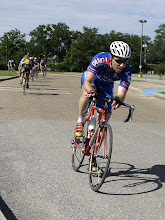Working on smoothness
I guess this is another "Roller boy" post. But, I can't express enough about the improvements that can be made by using rollers for regular training.
I would guess that I have about 10 hours on the rollers over the last 2-3 weeks. In addition to quantity, I really want to focus on quality. On the rollers, there are gross errors which alter your position on the cylinders(to the point of being ejected) and there are fine errors. The gross errors resolve themselves pretty quickly as you learn to pedal circles. Within, just a few rides, you can maintain a position within a 5" space for short periods of time. This is a good thing because, your general safety improves as well.
Fine errors are harder to percieve and harder to correct. These errors don't necessarily change your position on the cylinders. They aren't caused by weight shifts that result for poor pedaling mechanics. Fine errors are caused by alterations of pedaling speed within the cadence. It is possible to pedal circles, yet still apply peak forces to the pedals.
How do you diagnose fine errors?
Place a marker(piece of paper, kids toy etc) on the floor in front of the rollers. You want it to be far enough in front of you that it lines up with the horizon of the front wheel. As you ride, watch the relationship between the tire and the marker. If you see the tire surge forward, you are appling a peak force that should be controled. This is caused by an acceleration of the bike on the rollers as the bike tries to climb the cylinders. The goal here is high average force all the way around the pedal circle.
This should be diagnosed at all speeds. It may be that you are able to ride effectively at slow or moderate speeds but you have problems at high speeds. It's also good to evaluate this at a variety of cadences within a set gear combination.


0 Comments:
Post a Comment
<< Home